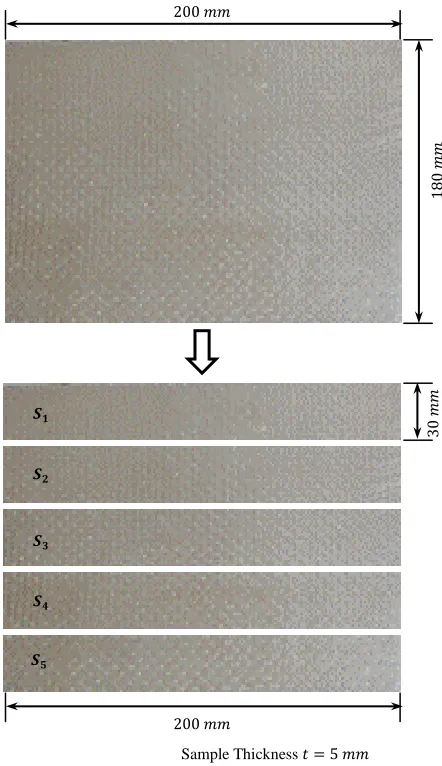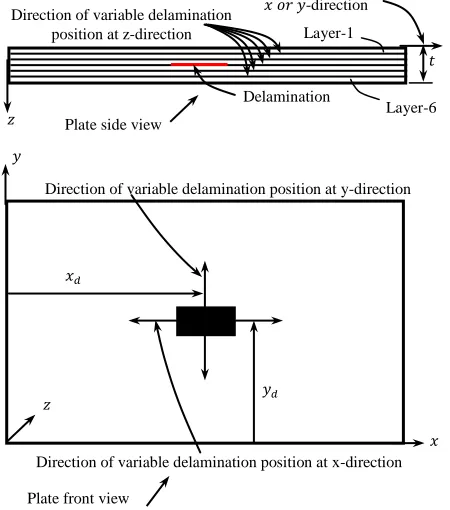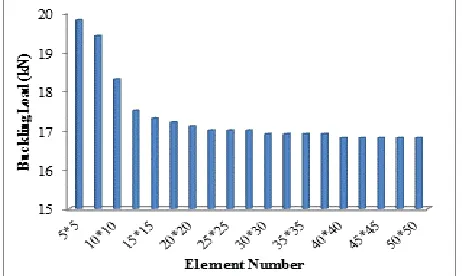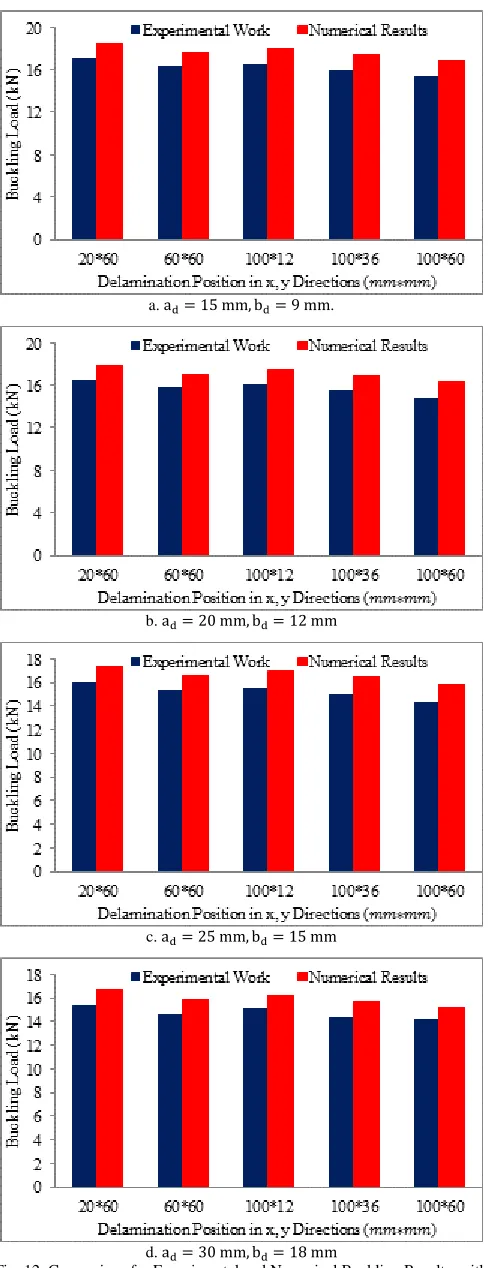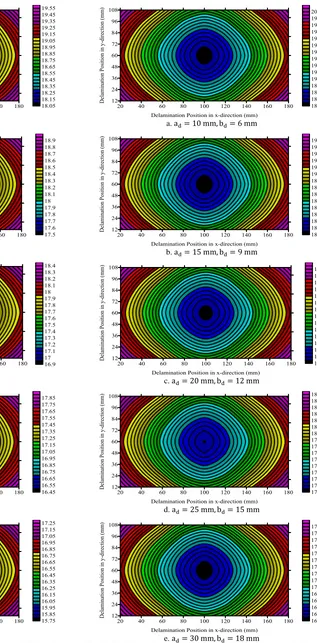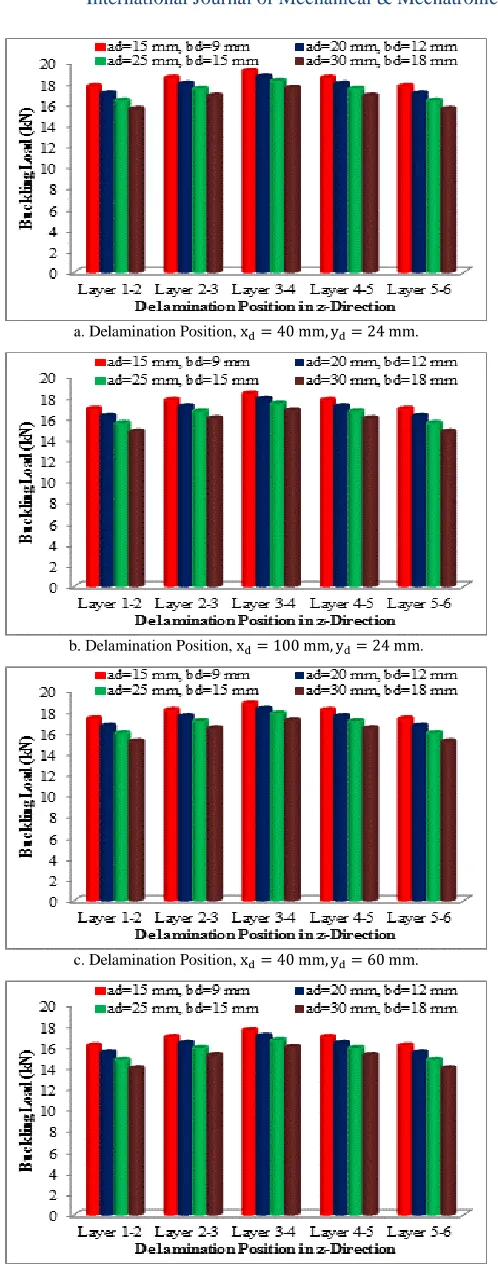Delamination Damage Effect on Buckling Behavior
of Woven Reinforcement Composite Materials Plate
Mahmud Rasheed Ismail
1, Zaman Abud Almalik Abud Ali
2, Muhannad Al-Waily
31Al-Nahrain University, College of Engineering, Prosthetics and Orthotics Engineering Department, Iraq
2,3University of Kufa, Faculty of Engineering, Mechanical Engineering Department, Iraq
Corresponding Author: Muhannad Al-Waily, Mechanical Engineering Department, muhanedl.alwaeli@uokufa.edu.iq
Abstract— The delamination is defect which leads to reduce the mechanical properties of composite structure, as a results different mechanical behavior of the structure can be altered. Since the buckling behavior is one the most important mechanical behavior of composite structure for many engineering application. Then, it is necessary to investigate the effect of various delamination parameters, such as size (dimensions of delamination) and position (at x, y, and z-directions) on the buckling characterization of composite plate structure. The present study includes evaluating of the critical buckling load by using two techniques. First, experimental techniques, by testing the plates manufactured samples (including delamination) with buckling test, As well as, evaluating the mechanical properties of materials which are necessary to be used as input data for numerical techniques. Second, numerical technique by using Ansys program as an application of finite element method. A comparison between the results of the two methods are made to show the validity of these techniques. A model of composite plate combined from glass woven reinforcement fiber and epoxy resin materials with six layers is fabricated and tested, the plate is clamped supported from two edge and free supported from other edges. The comparison between the results shows an acceptable agreement between the experimental and numerical analysis where the error is not exceed about (10.7%). Finally, the results show that the delamination leads to reduce the buckling strength of composite plate structure, with the increasing of the delamination size and as the location is approached the point at which the maximum bending moment occurs.
Index Term— Delamination Effect, Delamination Buckling, Composite Buckling, Delamination Size Buckling.
I. INTRODUCTION
Delamination is a defect occurred at composite materials due to manufacturing or through the service of structure. In addition to, the delamination is a failure occurs in the inter-laminar for laminated structure. Where, many causes lead to growth of delamination as impact with; low velocity, fatigue load, vibration behavior, buckling load, stress concentration, or other causes. In addition, it may lead to growth of other defect types such as internal and surface crack, [1-3], at different structure. Thus, different types of delamination production in composite laminated structure depending on the applied loads; first, internally, and second, delamination near of the surface, [4]. Therefore, its defect can influence the mechanical properties of the structure and hence, change the mechanical behavior of the composite materials of the structure. Due to the wide variety of application of composite materials structure in engineering, [5-6], and its application to
buckling load, [7], then it is interested to investigation the effect of defect under buckling behavior for composite plate structure. Many researchers investigated buckling behavior for different composite structures (plate and beam) with various delamination parameters (size and position), Different technique (experimental, numerical and mathematical) are used for evaluations as it is shown in the following brief survey;
was used via finite element technique including three dimension analysis. The study included an analytical solution for buckling behavior of laminated composite plate without delamination and comparison between the results of methods. At, 2009, H. Suemasu et. al, [12], investigated the behavior of post-buckling and buckling load behavior for composite plate with various effect of multi-delamination defect for circular shape type. Numerical and experimental techniques are attempted to evaluate the behavior for composite structure. The model included asimply supported plate under compression buckling load. A numerical technique with three dimensional brick element and approximated solution for contact surface for delamination technique is used. A spring element is employed for delamination the position to evaluate its behavior. In addition, the numerical results were validated by experimental results. At the same year, M. Damghani, [4], investigated the effect of delamination on the behavior of buckling load for composite plate structure by using stiffness technique. So that the stiffness technique can be used to evaluate the potential energy for composite plate with delamination defect, and hence to calculate the buckling plate. At, 2013, H. E. Balcioglu et. al, [13], Presented analysis for lateral buckling behavior of composite laminated structure with various delamination parameters effect. The investigation included the evaluation of the lateral buckling load for composite structure by using numerical and experimental techniques. The materials were used for fabricating the composite structure samples were combined from eight woven glass reinforcement fiber and epoxy resin materials. The manufacturing process included the using of layup hand technique. Two types for delamination shape were investigated to show the effect of lateral buckling behavior for composite. The main parameters studded are ; delamination shape ( circular and square ), size and position. Finally, the experimental results were compared with the numerical results. The comparison shows a good agreement. At, 2014, A. A. Julias et. al, [14], investigated the effect of delamination with various parameters, on the laminated composite plate structure, combined form two types of unidirectional reinforcement fiber (glass fiber and carbon fiber) and resin materials. The investigation based on experimental technique to evaluate the buckling behavior for the structure with various delamination parameters influence. Finite element technique is employed to calculate nonlinear behavior for laminated for symmetric and anti-symmetric cases with various delamination size and position effect. It is concluded that ;the delamination behavior for hyper composite structure, combined from unidirectional glass and carbon fiber, is reduced by increasing delamination size and decrease as the delamination close to the surface of laminated structure. At, 2017, A. Kollner et. al, [15] investigated a post-buckling and buckling behavior for struts made from composite materials with influence of various delamination parameters under the effect of compressive uniaxial load. The struts model is combined from multi-unidirectional reinforcement layer laminated. The study includes the investigation of non-linear behavior of the struts. A mathematical model with
minimizing potential energy is used to evaluate the buckling and post-buckling behavior for composite laminated struts structure with various delamination size and position (through area and thickness for struts).
Finally, at 2018, G. Ipek et. al, [16], presented experimental investigation for displacement-buckling force relation and buckling behavior for composite materials structure with various influence of delamination size and position, through the thickness for materials structure. Where, the composite structure was manufactured of eight layer with variable delamination positions through the layers 5 to 8, and different delamination size. The study included two parts, first, evaluated the displacement-force buckling applied relation with various parameters for delamination effect, such as size and position delamination through the thickness of the structure, and second, evaluating the effects of the studied parameters on buckling behavior for composite plate clamped at two edges and free at the other edges.
As a summary of the previous survey it can be seen that; there are many investigation for buckling behavior of unidirectional reinforcement composite structure existed in the literature in which the effect of delamination for woven reinforcement for beam or plate structure with various delamination position through the structure thickness only and for variable size for delamination in one direction only, parallel to applied compression load are presented. Therefore, in the present research the effects of different parameters for delamination, different delamination area size (length and width) and various position (through x, y, and z-direction), on the behavior of buckling load of composite plate structure combined from six layer reinforcement by glass woven fiber and epoxy resin materials are presented and investigated. The investigation of this work includes; an experimental technique to manufacture the plate samples, testing and calculating buckling critical load. Also, preparing samples for tensile tests in order to evaluate the mechanical properties. Finally; finite element technique is used to validate the experimental results.
II. EXPERIMENTAL TECHNIQUE
Fig. 1. ASTM S3039/D03039M Tensile Sample Standard.
Fig. 2. Preparing of Tensile Sample from Composite Plate According to ASTM (D3039/D03039M).
The weight required for the tensile samples can be calculated by using the following relations;
(1)
Where, and and and are; weight, mass density and volume required for reinforcement woven and resin materials, respectively, for manufacturing sample. Therefore, the density for each glass and epoxy resin materials can be evaluated experimentally by application of Archimedes principle in term of the mechanical properties of the composition materials [36], The results are listed in Table I.
To ensure that bubbles are not formed in samples the manufactured sample are subjected to high pressure by using block as shown in Fig. 3. [37]. Universal tensile machine is used for evaluating the mechanical properties for composite materials. In this regard, the modulus of elasticity for the materials was measured from stress-strain curve for five tested samples and the average was taken assuming an orthotropic materials the values of the three modulus are; (
). However, the other required properties such
as; shear modulus of elasticity and Poisson’s ratio. Are evaluated from mathematical model by using the following equations, [38-39],
( )
(2)
Where, is shear modulus of elasticity for composite material, and are shear modulus of elasticity for resin and reinforcement fiber materials, respectively, is Poisson’s ratio for composite material, and, and are Poisson’s ratio for reinforcement fiber and resin material, respectively.
Table I
Density and Mechanical Properties for Reinforcement Glass Woven Fiber and Epoxy Resin Material.
Parameter Glass Fiber Epoxy Resin
Density ( ) 2200 1100
Shear Modulus (GPa) 30 1.6
Poisson’s Ratio 0.25 0.4
Tensile Strength (MPa) 2500 130
Modulus of Elasticity (GPa) 74 4.5
Fig. 3. Block used to Sample Manufacturing.
Then, by substation the values for mechanical properties of resin and fiber reinforcement materials presented in Table I, into Eq. 2, the required mechanical properties for composite materials (combined from glass fiber reinforcment and epoxy resin material) can be obtained as presented in Table II. The composite plate samples was fabricated by combining six layer (each layer contains fiber reinforcement and epoxy resin material) with different delamination size and position through x, y, and z direction.
Lo
w
er
B
as
es
Jac
k
C
o
v
er
U
p
p
er
B
ases
A
p
p
li
ed
Lo
ad
Sample Thickness
Table II
Measured and Calculated Mechanical Properties of Composite used in Testing
Parameter Value
Shear Modulus (GPa) 2.58
Poisson’s Ratio 0.34
Modulus of Elasticity (GPa) 17.34
Fig. 4. shows the plate sample with delamination, while Fig. 5. Shows the dimensions of plate and delamination, in addition to, the location of delamination in the plate. The manufactured buckling samples with various delamination positions at x, y and z-direction, and different delamination size are given in Table III. In order to measure the critical load of buckling the universal tensile machine is used as shown in Fig. 6, Different plate samples with different delamination parameters influence were tested.
Fig. 4. Dimensions of Delamination and Buckling Composite Plate Samples.
Fig. 5. Direction of Delamination Position Variable Through x, y and z-Direction for Composite Plate Structure with Six Layers.
Table III
Location in x, y And z, Directions and Size of Delamination Samples. Variable for delamination position in x,
y, and z-direction
Delamination size -direction,
-direction, -direction
to
to
Between layer 1-2
to
to Between
layer 2-3 Between layer 3-4 Between layer 4-5 Between layer 5-6
Fig. 6. Buckling Testing for Composite Plate Samples.
To calculate the critical load buckling the compression-load curve for each sample is evaluates as shown in Fig. 7, From these curves the critical load buckling represents the point of transformation of linear behavior to the second behavior in the compression-load relation, as clarifies in Fig. 7, [37]. Many samples with various delamination parameters influence are prepared the detailed are given in Table III. For the comparison purpose and validation, the same samples are used for the numerical solution by using finite element techniques.
Fig. 7. Compression-Load Relation for Buckling Test. Compression strain
C
o
m
p
re
ss
io
n
l
o
ad
Buckling load Supported parts Move parts
Computer output read
Control part
Delamination Plate sample
Direction of variable delamination position at y-direction
Direction of variable delamination position at x-direction
Plate front view
Direction of variable delamination position at z-direction
Delamination
Plate side view
-direction
Layer-1
Layer-6
Delamination Plate thickness
III. NUMERICAL TECHNIQUE
The experimental techniques are perfect tools which can be used to measure and calculate the mechanical behavior of many types of structure, [40-46], However for buckling tests the experiments are suit for limited boundary conditions of plate such as fixed from two ends and free from the other two ends while it is difficult to be used for many other boundary conditions so that using numerical method to evaluate the critical load of buckling and buckling analysis represents as an alternative choice. as well as ; the experimental technique can serve for the validation of the numerical technique by comparing the results, [47-53]. In performing the numerical technique such as finite element method it is essential to select the best type of element to suit for evaluating the mechanical behavior of structures, [54-57]. In case of buckling analysis of composite plate with various delamination parameters effect, ;Solid 187, Shell 218, and Solid 168 are widely used, [58-62]. So that, in this work Shell element is selected for investigation buckling behavior of composite plate, as shown in Fig. 8, [63]. This element has three displacement in Cartesian coordinate, with 16 nods which can be used for large and small displacement and for stress analysis [63].
Fig. 8. Geometry of Shell Element used to Analysis Buckling Behavior.
Then, after selecting element types the number of element required to give best results by using mesh generation techniques, [64-70]. The optimum number of elements are about (25*25) as it is clear from Fig. 9. This figure shows the mesh generation for different element number used, for buckling behavior of composite plate structure studied. So, by using this number of elements, meshing the plate structure, as shown in Fig. 10, to evaluate the buckling behavior of plate with various parameters for delamination investigated in experimental work, as given in Table III. Also, by using the mechanical properties for composite layer presented in Table II, as a input data for program, Then, comparison between the numerical and experimental results are ready for evaluating the maximum error between the two results.
Fig. 9. Mesh Generation for Plate Composite Structure, for the Buckling Behavior for Plate with Delamination Influence.
Fig. 10. Mesh of Plate with Delamination Effect, by using (25*25) Elements.
IV. RESULTS AND DISCUSSION
The effect of delamination size and position are presented by two techniques used, first experimentally by testing the plate sample with buckling machine, and second, numerically which is used to validate Figs. 11 to 13 shown the experimental and numerical results for various crack size (length and width) and position (through x, y and thickness of laminated) effect. As it can be seen from these figures the maximum percentage error is about (10.7%). Then, after evaluated the agreement for results were calculated, presenting the effect of various delamination parameters on the buckling of plate. Figs. 14 to 16, shows the effect for delamination position at x and y-direction on the buckling behavior for plate structure with different delamination size and position through the thickness of laminated. In addition, Fig. 17, also, shows the effect of different delamination position through the plate laminated thickness with different other delamination parameters influences. As it is clear from this figure that the buckling behavior decreases with increasing of the delamination size (length or with), and the delamination position effect become large when at near the location for maximum bending moment effect at the plate. Therefore, the buckling behavior for plate decreases with delamination position at the center for plate (in x or y-direction) more than the decreasing when delamination is near the edge for plate. In addition, the buckling for plate with delamination position between layer 1-2 (near the surface for plate) is less than that for plate with delamination position between layers 3-4 (near the center for plate). The reason for this behavior can be attributed due to the decreasing in the properties for composite materials plate, Also. Due to the effect of stress concentration about laminated defect that leads to further decreasing in the mechanical properties of the structure.
a. .
b.
c.
d.
Fig. 11. Comparison of Experimental and Numerical Buckling Results, with Delamination Position in z-Direction between Layer-1 and Layer-2 for Plate.
a. .
b.
c.
d.
a. .
b.
c.
d.
Fig. 13. Comparison for Experimental and Numerical Buckling Results, with Delamination Position in z-Direction between Layer-3 and Layer-4 for Plate.
a. .
b.
c.
d.
e. .
a.
b.
c.
d.
e.
Fig. 15. Buckling behavior for plate with delamination between 2-3 layer in z-direction and various position in x and y and size.
a.
b.
c.
d.
e.
a. Delamination Position, .
b. Delamination Position, .
c. Delamination Position, .
d. Delamination Position, . Fig. 17. Buckling behavior for plate with various delamination size effect and
different delamination position in x, y, and z-directions influence.
V. CONCLUSIONS
The presented investigation include the analysis of delamination influence buckling behavior of composite plate structure, which combined from six layer reinforcement by woven glass fiber and using epoxy resin materials as matrix material, with various delamination parameters effect (size and location influence). experimental and numerical technique are employed to evaluating buckling load and buckling behavior. from the presented work many impartment point can be concluded and as the following;
1. The experimental work offer a good technique for manufacturing and preparing test samples to evaluate the mechanical properties and buckling behavior for composite structure, which can be used for different application with various defect influence.
2. The numerical technique which is using finite element method via Ansys program regard as an effective tool for analyzing composite structure with various defect effect with acceptable error (not exceeded 10.7% for the worst cases ).
3. The delamination defect leads to reduce the strength for composite materials structure. Then, the delamination defect lead to reduce the mechanical behavior for its structure, then, the buckling behavior reduces due to the delamination effect.
4. The position of delamination effect (through x-y directions) has more value when its position occurs at the maximum bending stress for plate section. Then the maximum effect for delamination position occurs at the middle section of plate structure or at the maximum bending moment of plate when it is supported as fixed for two edges and free for other two edges. So the buckling decreases with delamination position near the middle section of plate.
5. The effect of delamination position in z-direction increases at delamination position near the upper or lower surface for composite laminated plate structure. Thus, the effect of delamination on the buckling behavior increases with delamination position near the surface of plate. Also the mechanical properties decrease with delamination position near section of maximum stress. Then, the buckling resistance behavior for plate decrease at the delamination position near the surface for the plate.
ACKNOWLEDGMENT
The authors would like to express thanks for the Mechanical Engineering Department at Faculty of Engineering at University of Kufa, and Prosthetics and Orthotics Engineering Department at College of Engineering at Al-Nahrain University, Iraq.
REFERENCES
[1] Muhsin J. Jweeg, Ali S. Hammood, Muhannad Al-Waily ‘A Suggested Analytical Solution of Isotropic Composite Plate with Crack Effect’ International Journal of Mechanical & Mechatronics Engineering IJMME-IJENS, Vol. 12, No. 05, 2012.
[3] Muhsin J. Jweeg, E. Q. Hussein, K. I. Mohammed ‘Effects of Cracks on the Frequency Response of a Simply Supported Pipe Conveying Fluid’ International Journal of Mechanical & Mechatronics Engineering IJMME-IJENS, Vol. 17, 05, 2017.
[4] Mahdi Damghani ‘Buckling Behaviour of Delaminated Composite Plates Using Exact Stiffness Analysis’ Ph.D. Thesis, Cardiff University, Cardiff School of Engineering, Division of Structural Engineering, 2009.
[5] Muhsin J. Jweeg, Ali S. Hammood, Muhannad Al-Waily ‘Analytical Solution to Oblique Crack Effect in Different Types of Composite Plates’ ARPN Journal of Science and Technology, Vol. 2, No. 8, 2012. [6] Muhannad Al-Waily ‘Theoretical and Experimental Vibration Study of
Continuous Beam With Crack Depth and Location Effect’ Indian Journal of Applied Research (IJAR), Vol. 3, No. 9, 2013.
[7] Muhannad Al-Waily, Alaa Abdulzahra Deli ‘A suggested analytical solution of buckling investigation for beam with different crack depth and location effect’ International Journal of Energy and Environment, Vol. 7, No. 3, 2016.
[8] G. A. Kardomateas, D. W. Schmueser ‘Buckling and Postbuckling of Delaminated Composites Under Compressive Loads Including Transverse Shear Effects’ AIAA Journal, Vol. 26, No. 03, 1988. [9] M. Somers, T. Weller, H. Abramovich ‘Buckling and Postbuckling
Behavior of Delaminated Sandwich Beams’ Composite Structures, Vol. 21, pp. 211-232, 1992.
[10] Baoxiang Shan, Assimina A. Pelegri ‘Approximate Analysis of the Buckling Behavior of Composite with Delamination’ Journal of Composite Materials, Vol. 37, No. 08, 2003.
[11] Mehmet Zor, Faruk Sen, Evren Toygar ‘An Investigation of Suare Delamination Effect on the Buckling Behavior of Laminated Composite Plates with a Square Hole by using Three-Dimensional FEM Analysis’ Journal of Reinforced Plastics and Composites, Vol. 24, No. 11, 2005. [12] Hiroshi Suemasu, Takeshi Irie, Takashi Ishikawa ‘Buckling and
Pos-Buckling Behavior If Composite Plates Containing Multiple Delaminations’ Journal of Composite Materials, Vol. 43, No. 02, 2009. [13] H. Ersen Balcioglu, Mehmet Aktas ‘An Investigation on Lateral
Buckling of Laminated Composites with Delamination’ Indian Journal of Engineering and Materials Sciences, Vol. 20, pp. 367-375, 2013. [14] A. Arockia Julias, Sufean Abdulhakeem Mohmeed, Vela Murali ‘Effect
of Delamination on Buckling Strength of Unidirectional Glass-Carbon Hybrid Laminates’ Indian Journal of Engineering and Materials Sciences, Vol. 21, pp. 23-29, 2014.
[15] Anton Kollner, Christina Vollmecke ‘Buckling and Postbuckling Behavior of Delaminated Composite Struts’ International Journal for Computational Methods in Engineering Science and Mechanics, Taylor and Francis, Vol. 18, No. 01, pp. 25-33, 2017.
[16] Galip Ipek, Yusuf Arman, Abdullah Celik ‘The Effect of Delamination Size and Location to Buckling Behavior of Composite Materials’ Elsevier, Science Direct, Composites Part B-Engineering, Vol. 155, pp. 69-79, 2018.
[17] Muhsin J. Jweeg, Sameer Hashim Ameen ‘Experimental and theoretical investigations of dorsiflexion angle and life of an ankle-Foot-Orthosis made from (Perlon-carbon fibre-acrylic) and polypropylene materials’ 10th IMEKO TC15 Youth Symposium on Experimental Solid Mechanics, 2011.
[18] Bashar A. Bedaiwi, Jumaa S. Chiad ‘Vibration Analysis and Measurement in the Below Knee Prosthetic Limb: Part I-Experimental Work’ ASME 2012 International Mechanical Engineering Congress and Exposition, Proceedings (IMECE), 2012.
[19] Ayad M. Takhakh, Fahad M. Kadhim, Jumaa S. Chiad ‘Vibration Analysis and Measurement in Knee Ankle Foot Orthosis for Both Metal and Plastic KAFO Type’ ASME 2013 International Mechanical Engineering Congress and Exposition IMECE2013, November 15-21, San Diego, California, USA, 2013.
[20] Jumaa S. Chiad ‘Study the impact behavior of the prosthetic lower limb lamination materials due to low velocity impactor’ ASME 2014 12th Biennial Conference on Engineering Systems Design and Analysis, ESDA, 2014.
[21] Ahmed M. Hashim, E. K. Tanner, Jawad K. Oleiwi ‘Biomechanics of Natural Fiber Green Composites as Internal Bone Plate Rafted’ MATEC Web of Conferences, 2016.
[22] Mohsin Abdullah Al-Shammari, Emad Q. Hussein, Ameer Alaa Oleiwi ‘Material Characterization and Stress Analysis of a Through Knee
Prosthsis Sockets’ International Journal of Mechanical & Mechatronics Engineering IJMME-IJENS, Vol. 17, No. 06, 2017.
[23] Muhsin J. Jweeg, A. A. Alhumandy, H. A. Hamzah ‘Material Characterization and Stress Analysis of Openings in Syme’s Prosthetics’ International Journal of Mechanical & Mechatronics Engineering IJMME-IJENS, Vol. 17, No. 04, 2017.
[24] Jawad K. Oleiwi, Ahmed Namah Hadi ‘Experimental and numerical investigation of lower limb prosthetic foot made from composite polymer blends’ International Journal of Mechanical and Production Engineering Research and Development, Vol. 08, No. 02, pp. 1319-1330, 2018.
[25] Mahmud Rasheed Ismail, Muhannad Al-Waily, Ameer A. Kadhim ‘Biomechanical Analysis and Gait Assessment for Normal and Braced Legs’ International Journal of Mechanical & Mechatronics Engineering IJMME-IJENS, Vol. 18, No. 03, 2018.
[26] Ayad M. Takhakh ‘Manufacturing and Analysis of Partial Foot Prosthetic for The Pirogoff Amputation’ International Journal of Mechanical & Mechatronics Engineering IJMME-IJENS, Vol. 18, No. 03, pp. 62-68, 2018.
[27] Saif M. Abbas, Ayad M. Takhakh, Mohsin Abdullah Al-Shammari, Muhannad Al-Waily ‘Manufacturing and Analysis of Ankle Disarticulation Prosthetic Socket (SYMES)’ International Journal of Mechanical Engineering and Technology (IJMET), Vol. 09, No. 07, pp. 560-569, 2018.
[28] D3039/D03039M ‘Standard Test Method for Tensile Properties of Polymer Matrix Composite Materials’ Annual Book of ASTM Standards, 15, 1995.
[29] Abdulkareem Abdulrazzaq Alhumdany, Muhannad Al-Waily, Mohammed Hussein Kadhim ‘Experimental Investigation for Powder Reinforcement Effect on Mechanical Properties and Natural Frequency of Isotropic Hyper Composite Plate with Various Boundary Conditions’ International Journal of Energy and Environment, Vol. 6, No. 5, pp. 449-516, 2015.
[30] A. R. I. Kheder, N. M. Jubeh, E. M. Tahah ‘Fatigue behavior of alloyed acicular ductile iron’ International Journal for the Joining of Materials, Vol. 17, No. 01, pp. 7-12, 2005.
[31] A. R. I. Kheder, N. M. Jubeh, E. M. Tahah ‘Fatigue properties under constant stress/variable stress amplitude and coaxing effect of acicular ductile iron and 42 CrMo4 steel’ Jordan Journal of Mechanical and Industrial Engineering, Vol. 05, No. 04, 2011.
[32] Muhannad Al-Waily ‘Experimental and Numerical Vibration Study of Woven Reinforcement Composite Laminated Plate with Delamination Effect’ International Journal of Mechanical Engineering (IJME), IASET, Vol. 2, No. 5, 2013.
[33] Abdulkareem Abdulrazzaq Alhumdany, Muhannad Al-Waily, Mohammed Hussein Kadhim Al-Jabery ‘Theoretical and Experimental Investigation of Using Date Palm Nuts Powder into Mechanical Properties and Fundamental Natural Frequencies of Hyper Composite Plate’ International Journal of Mechanical & Mechatronics Engineering IJMME-IJENS, Vol. 16, No. 01, 2016.
[34] Muhsin J. Jweeg, Muhannad Al-Waily ‘Experimental and numerical analysis of cross-ply and angle-ply composite laminated plates having various shapes of cut outs’ International Journal of Energy and Environment, Vol. 7, No. 6, 2016.
[35] Ameer A. Kadhim, Muhannad Al-Waily, Zaman Abud Almalik Abud Ali, Muhsin J. Jweeg, Kadhim K. Resan ‘Improvement Fatigue Life and Strength of Isotropic Hyper Composite Materials by Reinforcement with Different Powder Materials’ International Journal of Mechanical & Mechatronics Engineering IJMME-IJENS, Vol. 18, No. 02, 2018. [36] Daniel Gay, Suong V. Hoa, Stephen W. Tsai ‘Composite Materials
Design and Applications’ CRC Press LLC, 2003.
[37] Muhannad Waily, Alaa Abdulzahra Deli, Aziz Darweesh Al-Mawash, Zaman Abud Almalik Abud Ali ‘Effect of Natural Sisal Fiber Reinforcement on the Composite Plate Buckling Behavior’ International Journal of Mechanical & Mechatronics Engineering IJMME-IJENS, Vol. 17, No. 01, 2017.
[39] Muhannad Al-Waily ‘Analytical and Experimental Investigations Vibration Study of Isotropic and Orthotropic Composite Plate Structure with Various Crack Effect’ International Energy and Environment Foundation, 2017.
[40] Ghaith G. Hameed, Muhsin J. Jweeg, Ali Hussein ‘Springback and side wall curl of metal sheet in plain strain deep drawing’ Research Journal of Applied Sciences, Vol. 04, No. 05, pp. 192-201, 2009.
[41] Muhsin J. Jweeg, Kadhim K. Resan, Mustafa Tariq Ismail ‘Study of Creep-Fatigue Interaction in a Prosthetic Socket Below Knee’ ASME International Me.chanical Engineering Congress and Exposition, 2012. [42] Adnan S. Jabur, Jalal M. Jalil, Ayad M. Takhakh ‘Experimental
Investigation and Simulation of Al-Si Casting Microstructure Formation’ Arabian Journal for Science and Engineering, Vol. 37, No. 03, pp. 777-792, 2012.
[43] Ayad M. Takhakh, Raied Z. Alfay, Abdul Rahim K. Abid Ali ‘Effect of Ta addition on hardness and wear resist of Cu-Al-Ni shape memory alloy fabricated by powder metallurgy’ BEIAC 2013-2013 IEEE Business Engineering and Industrial Applications Colloquium, 2013. [44] Zainab Yousif Hussien, Kadhim Kamil Resan ‘Effects of Ultraviolet
Radiation with and without Heat, on the Fatigue Behavior of Below-Knee Prosthetic Sockets’ International Journal of Mechanical and Production Engineering Research and Development (IJMPERD), Vol. 07, No. 06, 2017.
[45] Abeer R. Abbas, Kadhim A. Hebeatir, Kadhim K. Resan ‘Effect of CO2 Laser on Some Properties of NI46TI50CU4 Shape Memory Alloy’ International Journal of Mechanical and Production Engineering Research and Development, Vol. 08, No. 02, pp. 451-460, 2018. [46] Ahmed Khaleel Abdulameer, Mohsin Abdullah Al-Shammari ‘Fatigue
Analysis of Syme’s Prosthesis’ International Review of Mechanical Engineering, Vol. 12, No. 03, 2018.
[47] Luay S. Al-Ansari, Muhannad Al-Waily, Ali M. H. Yusif ‘Vibration Analysis of Hyper Composite Material Beam Utilizing Shear Deformation and Rotary Inertia Effects’ International Journal of Mechanical & Mechatronics Engineering IJMME-IJENS, Vol. 12, No. 04, 2012.
[48] Muhannad Al-Waily ‘Investigation of Health Monitoring of Composite Plate Structures-Using Vibration Analysis’ Ph. D. Thesis, Alnahrain University, College of Engineering, Mechanical Engineering Department, 2012.
[49] Mohsin Abdullah Al-Shammari, Muhannad Al-Waily ‘Theoretical and Numerical Vibration Investigation Study of Orthotropic Hyper Composite Plate Structure’ International Journal of Mechanical & Mechatronics Engineering IJMME-IJENS, Vol. 14, No. 06, 2014. [50] Muhannad Al-Waily, Zaman Abud Almalik Abud Ali ‘A Suggested
Analytical Solution of Powder Reinforcement Effect on Buckling Load for Isotropic Mat and Short Hyper Composite Materials Plate’ International Journal of Mechanical & Mechatronics Engineering IJMME-IJENS, Vol. 15, No. 04, 2015.
[51] Muhannad Al-Waily, Kadhim K. Resan, Ali Hammoudi Al-Wazir, Zaman Abud Almalik Abud Ali ‘Influences of Glass and Carbon Powder Reinforcement on the Vibration Response and Characterization of an Isotropic Hyper Composite Materials Plate Structure’ International Journal of Mechanical & Mechatronics Engineering IJMME-IJENS, Vol. 17, No. 06, 2017.
[52] Kadhim K. Resan, Abbas A. Alasadi, Muhannad Al-Waily, Muhsin J. Jweeg ‘Influence of Temperature on Fatigue Life for Friction Stir Welding of Aluminum Alloy Materials’ International Journal of Mechanical & Mechatronics Engineering IJMME-IJENS, Vol. 18, No. 02, 2018.
[53] Muhsin J. Jweeg ‘A Suggested Analytical Solution for Vibration of Honeycombs Sandwich Combined Plate Structure’ International Journal of Mechanical & Mechatronics Engineering IJMME-IJENS, Vol. 16, No. 02, 2016.
[54] Muhsin J. Jweeg ‘Application of finite element analysis to rotating fan impellers’ Doctoral Thesis, Aston University, 1983.
[55] Muhannad Al-Waily, Maher A.R. Sadiq Al-Baghdadi, Rasha Hayder Al-Khayat ‘Flow Velocity and Crack Angle Effect on Vibration and Flow Characterization for Pipe Induce Vibration’ International Journal of Mechanical and Mechatronics Engineering IJMME-IJENS, Vol. 17, No. 05, pp.19-27, 2017.
[56] Rasha Hayder Al-Khayat, Maher A. R. Sadiq Al-Baghdadi, Ragad Aziz Neama, Muhannad Al-Waily ‘Optimization CFD Study of Erosion in
3D Elbow During Transportation of Crude Oil Contaminated with Sand Particles’ International Journal of Engineering & Technology, Vol. 07, No. 03, pp. 1420-1428, 2018.
[57] Mohsin Abdullah Shammari, Lutfi Y. Zedan, Akram M. Al-Shammari ‘FE simulation of multi-stage cold forging process for metal shell of spark plug manufacturing’ 1st International Scientific Conference of Engineering Sciences-3rd Scientific Conference of Engineering Science, ISCES 2018–Proceedings, 2018.
[58] Muhsin J. Jweeg, Muhannad Al-Waily ‘Determination of Inter-Laminar Shearing Stresses Using a Suggested Analytical Solution in the Composite Laminated Plates’ International Journal of Mechanical Engineering (IJME), IASET, Vol. 2, No. 5, 2013.
[59] Muhsin J. Jweeg, Muhannad Al-Waily, Alaa Abdulzahra Deli ‘Theoretical and Numerical Investigation of Buckling of Orthotropic Hyper Composite Plates’ International Journal of Mechanical & Mechatronics Engineering IJMME-IJENS, Vol. 15, No. 04, 2015. [60] Muhannad Al-Waily ‘Analytical and Numerical Thermal Buckling
Analysis Investigation of Unidirectional and Woven Reinforcement Composite Plate Structural’ International Journal of Energy and Environment, Vol. 6, No. 2, 2015.
[61] Muhannad Al-Waily ‘Analytical and Numerical Buckling and Vibration Investigation of Isotropic and Orthotropic Hyper Composite Materials Structures’ International Energy and Environment Foundation, 2015. [62] Mohsin Abdullah Al-Shammari, Muhannad Al-Waily ‘Analytical
Investigation of Buckling Behavior of Honeycombs Sandwich Combined Plate Structure’ International Journal of Mechanical and Production Engineering Research and Development (IJMPERD), Vol. 08, No. 04, pp. 771-786, 2018.
[63] M. L. Bucalem, K. J. Bathe ‘Finite Element Analysis of Shell Structures’ Archives of Computational Methods in Engineering, Vol. 04, No. 01, pp. 3-61, 1997.
[64] Muhsin J. Jweeg, Ali S. Hamood, Muhannad Al-Waily ‘A Suggested Analytical Solution of Orthotropic Composite Plate Structure with Crack Effect’ International Journal of Mechanical Engineering (IJME), IASET, Vol. 1, No. 2, 2012.
[65] Muhsin J. Jweeg, Ali S. Hammood, Muhannad Al-Waily ‘Experimental and Numerical Study of Oblique Crack Effect on Natural Frequency of Different Composite Plate Structure Types’ AT, Asian Transactions on Engineering, Vol. 2, No. 5, 2012.
[66] Muhannad Al-Waily ‘Theoretical and Numerical Vibration Study of Continuous Beam with Crack Size and Location Effect’ International Journal of Innovative Research in Science Engineering and Technology (IJIRSET), Vol. 2, No. 9, 2013.
[67] Ragad Aziz Neama, Maher A.R. Sadiq Baghdadi, Muhannad Al-Waily ‘Effect of Blank Holder Force and Punch Number on the Forming Behavior of Conventional Dies’ International Journal of Mechanical & Mechatronics Engineering IJMME-IJENS, Vol. 18, No. 04, 2018. [68] Saif M. Abbas, Kadhim K. Resan, Ahmed K. Muhammad, Muhannad
Al-Waily ‘Mechanical and Fatigue Behaviors of Prosthetic for Partial Foot Amputation with Various Composite Materials Types Effect’ International Journal of Mechanical Engineering and Technology (IJMET), Vol. 09, No. 09, pp. 383–394, 2018.
[69] Ayad M. Takhakh, Saif M. Abbas ‘Manufacturing and Analysis of Carbon Fiber Knee Ankle Foot Orthosis’ International Journal of Engineering & Technology, Vol. 07, No. 04, pp. 2236-2240, 2018. [70] Jumaa S. Chiad, Muhannad Al-Waily, Mohsin Abdullah Al-Shammari
